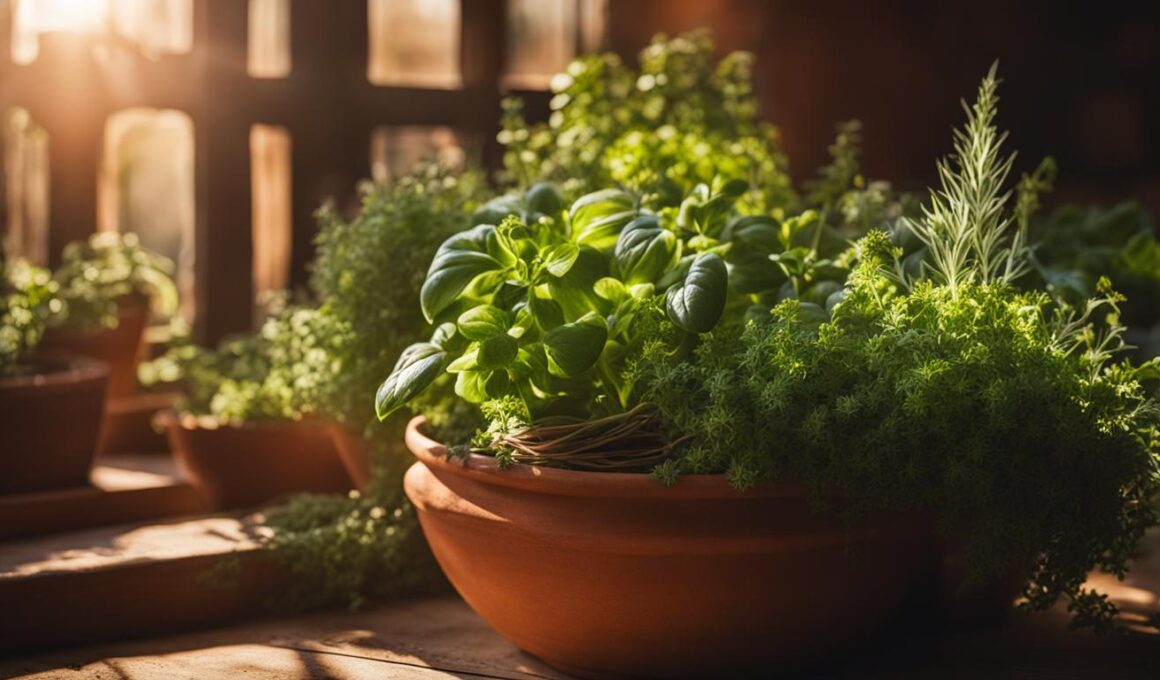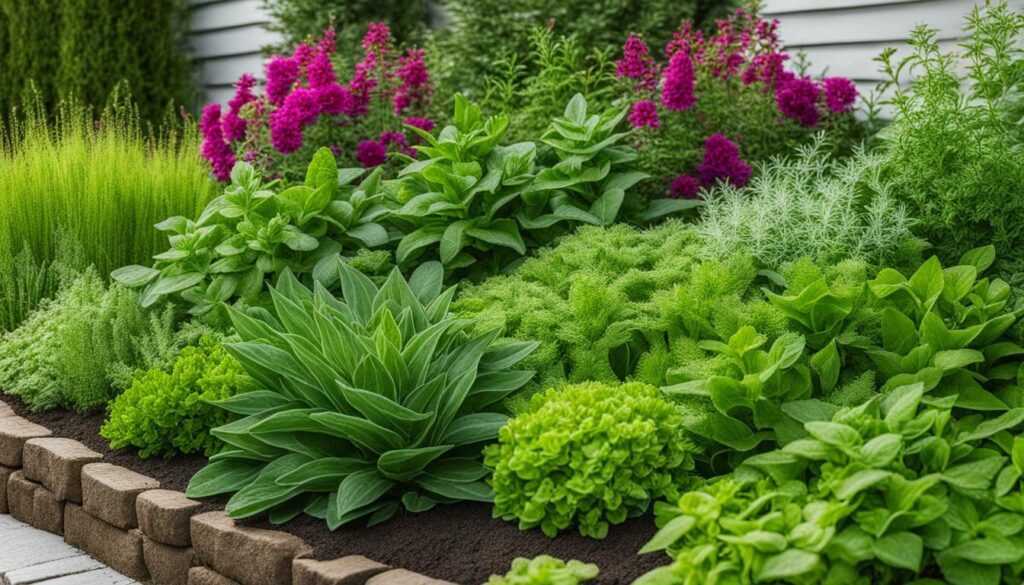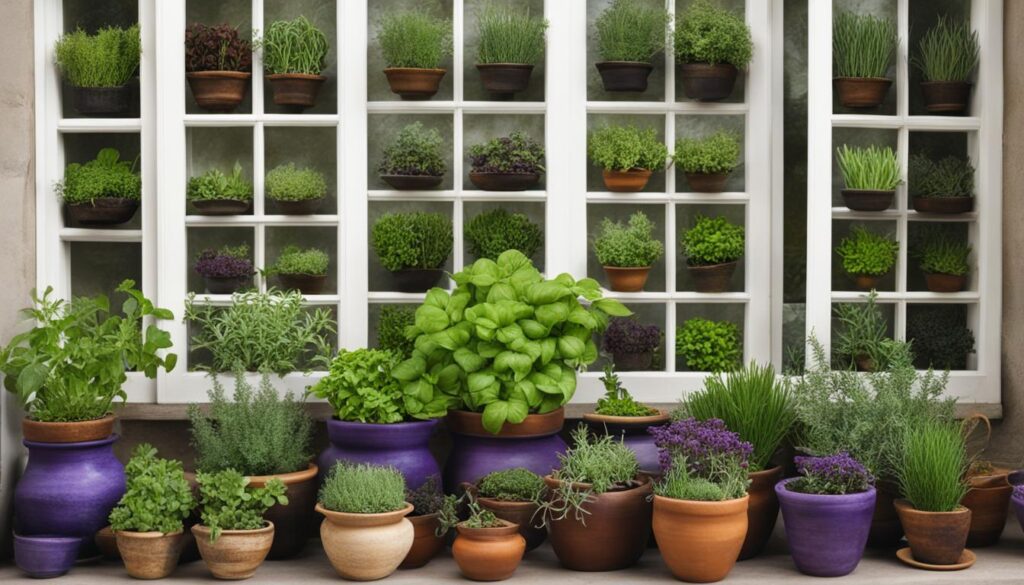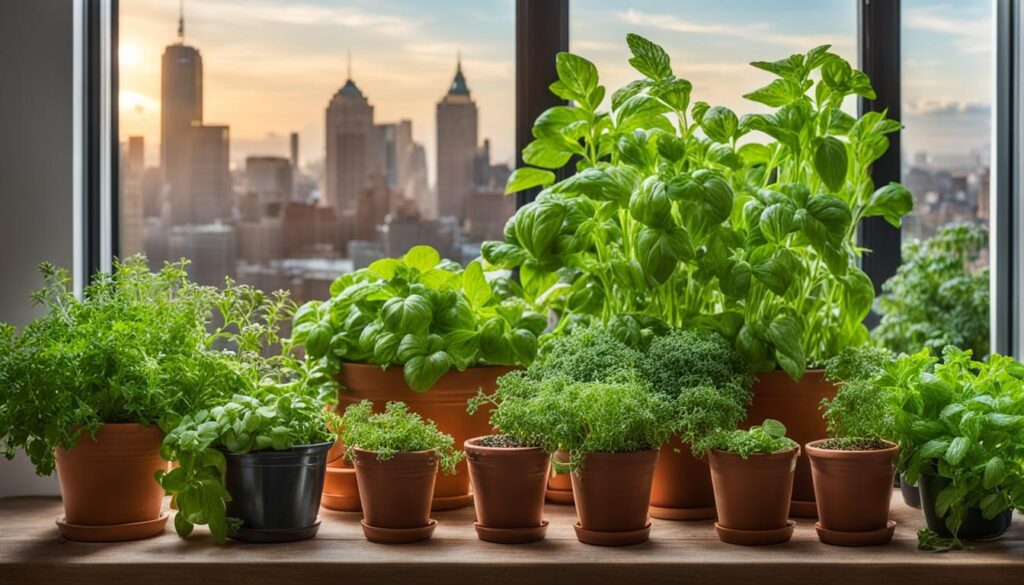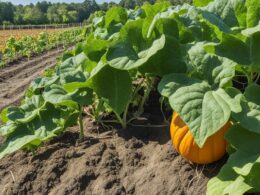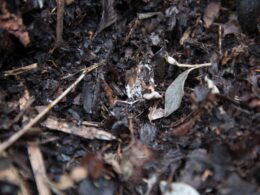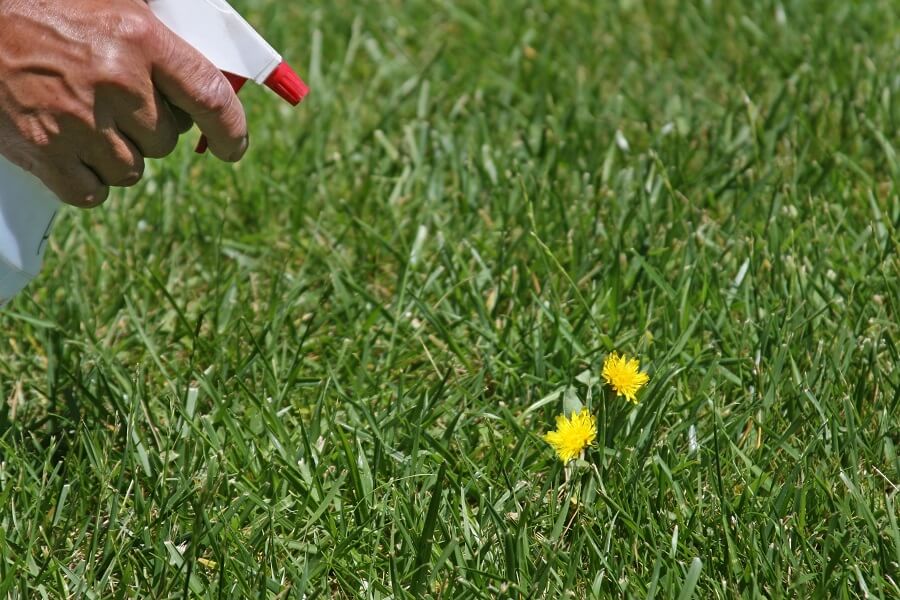Diverse herb gardening allows you to maximize your space and explore a variety of flavors and aromas in your own backyard. But can you really grow different herbs together in the same pot? The answer is yes! By understanding their growing requirements and considering companion planting, you can create a thriving herb garden that combines the best of nature’s bounty.
Companion planting is a clever technique that not only saves space but also improves the health and flavor of your herbs. When different herbs share a growing season and require similar amounts of light, water, and nutrition, they can be planted together in the same container. This method not only creates a visually appealing garden but also helps break up your garden space and reduces the risk of diseases.
Key Takeaways:
- Yes, you can grow different types of herbs together in one container.
- Companion planting saves space and improves the health of your plants.
- Consider the local gardening climate before choosing which herbs to plant together.
- Picking herbs regularly and feeding them with liquid seaweed promotes fuller growth and better flavors.
- Choose the right size container with proper drainage for successful herb gardening.
Benefits of Companion Planting
Companion planting offers a multitude of benefits for your herb garden. Not only does it save space, but it also improves moisture retention, reduces disease issues, and enhances the overall health of your plants. By growing different types of herbs together in one container, you can create a harmonious environment where the plants support and benefit each other.
One of the key advantages of companion planting is that it saves space. Instead of having separate pots for each herb, you can plant them together in a single container. This not only maximizes your growing area but also allows you to grow a diverse range of herbs in a small space. Plus, it adds visual interest to your garden with its beautiful mix of colors, textures, and aromas.
Companion planting not only saves space but also benefits the health of the plants. It improves moisture retention by reducing water evaporation and the need for frequent watering. Planting different herbs together can also help break up the garden and slow down the spread of diseases.
Furthermore, companion planting can help reduce disease issues. Certain herbs have natural pest-repelling properties or attract beneficial insects that prey on garden pests. By strategically pairing herbs with these properties, you can create a natural defense system for your plants. This reduces the need for chemical pesticides and promotes a healthier, more sustainable garden.
Overall, companion planting is a smart and effective way to grow herbs together in a container. It saves space, improves moisture retention, reduces disease issues, and enhances the health of your plants. So, why not experiment with companion planting in your herb garden and enjoy the numerous benefits it brings?
Choosing Herbs to Plant Together
When it comes to growing different herbs in the same pot, it’s important to consider your local gardening climate. The climate will determine which herbs can thrive together and create a harmonious growing environment. In mild to cool climates, you can often grow a variety of herbs together in the same container during the same growing season.
Moisture-loving herbs like basil, parsley, and lemon balm can be planted together as long as they have proper spacing and well-drained soil. These herbs require regular watering but should not be sitting in water to avoid root rot. On the other hand, Mediterranean herbs such as rosemary, cilantro, thyme, oregano, sage, chives, dill, and lavender prefer lots of sunlight and drier soil. These herbs are more tolerant of dry conditions and should be watered less frequently.
Mints, although delicious and aromatic, are best planted in a separate container due to their invasive nature. However, different varieties of mint can be grown together as long as they are contained within their own pot. This prevents them from spreading and taking over the other herbs in the container.
By understanding the specific needs of your herbs and considering the local gardening climate, you can create a successful herb garden in containers. This allows you to enjoy a variety of flavors and aromas while saving space and creating a beautiful display of diverse herb gardening.
Recommended Herbs to Grow in Containers
When it comes to growing herbs in containers, there are several options that thrive in this environment and can add flavor and aroma to your dishes. Here are some recommended herbs that you can easily grow in your own container garden:
- Mint: Mint is a versatile herb that can be used for various purposes and is easy to grow in containers. From refreshing beverages to savory dishes, mint adds a delightful freshness to your culinary creations. It’s important to note that mint can be quite invasive, so it’s best to plant it in a separate container to prevent it from taking over other herbs.
- Chives: Chives are known for their mild onion flavor and are great for adding a pop of color and taste to your dishes. They only require a few hours of sun each day, making them a perfect choice for container gardening.
- Sage, Bay, Thyme, and Rosemary: These classic herbs are packed with unique flavors and aromas that can elevate your cooking. They are suitable for soups, stocks, meats, and more. These herbs prefer well-drained soil and lots of sunlight, so be sure to provide them with the right conditions in your containers.
- Parsley: Parsley is a slow-growing herb that requires patience, but it’s worth the wait. Once established, parsley provides leaves for nearly two years, allowing you to have a steady supply of fresh herbs for your culinary creations.
- Coriander: Also known as cilantro, coriander is a popular herb in many cuisines. It’s best to plant coriander in the spring, as it prefers cooler temperatures. Coriander leaves can be harvested throughout the late autumn, providing a fresh and vibrant addition to your dishes.
- Basil: Basil thrives in warm, bright spots and can bring a burst of flavor to your recipes. It’s important to provide well-drained soil and water basil in the morning to prevent moisture-related issues.
- Sorrel: Sorrel adds a lemony bite to dishes and can be grown in containers with at least four hours of sun. It’s a unique herb that can make your recipes stand out.
These recommended herbs are just a starting point for your container herb garden. Feel free to experiment with different varieties and combinations to create a unique and flavorful garden that suits your taste.
Quote:
“Growing herbs in containers allows you to have a fresh supply of culinary delights right at your fingertips. Whether you have a small balcony or a spacious backyard, container herb gardening is a versatile and rewarding way to enjoy the flavors and aromas of different herbs.”
Tips for Growing Herbs in Containers
Growing herbs in containers can be a rewarding experience, allowing you to have fresh flavors right at your fingertips. To ensure successful herb gardening, here are some tips to keep in mind:
Picking Herbs
Picking herbs regularly is essential for encouraging fuller growth and ensuring a bountiful harvest. By removing the tips of each stem, you stimulate new growth and maintain the overall health of the plant. Whether you’re using the herbs for cooking or medicinal purposes, regular picking will keep your plants thriving.
Feeding with Liquid Seaweed
Feeding your herbs with liquid seaweed is a natural and effective way to promote their growth and enhance their flavor. Liquid seaweed is rich in essential nutrients that nourish the plants and improve their overall health. Simply dilute the liquid seaweed according to the manufacturer’s instructions and apply it to your herbs regularly for optimal results.
Container Size and Drainage
Choosing the right container size is crucial for the success of your herb garden. Most herbs thrive in five-liter pots, which provide enough space for their roots to grow and access the necessary nutrients. Additionally, proper drainage is essential to prevent over-watering and ensure the health of your plants. Make sure your containers have drainage holes and use well-draining soil to create a favorable growing environment.
By following these tips, you can enjoy the benefits of growing herbs in containers and create a thriving herb garden. Remember to pick your herbs regularly, feed them with liquid seaweed, and provide the appropriate container size and drainage. With proper care and attention, you’ll have a continuous supply of fresh herbs to elevate your culinary creations.
Additional Herbs to Consider Growing in Containers
If you’re looking to expand your herb garden and explore a wider range of flavors and aromas, there are several additional herbs that you can consider growing in containers. These herbs will not only add variety to your culinary creations but also provide beauty and fragrance to your garden. Here are some herbs that you can add to your collection:
- Lovage: Lovage is a perennial herb with a flavor similar to celery. Its leaves and stems can be used in soups, stews, and salads.
- Vietnamese Coriander: Also known as rau răm or laksa leaf, Vietnamese coriander has a unique spicy flavor that is perfect for Asian dishes and salads.
- Dill: Dill is a versatile herb that pairs well with seafood, eggs, and pickles. It also adds a fresh flavor to salads.
- Tarragon: Tarragon has a distinct anise-like flavor and is commonly used in French cuisine. It is great in chicken, fish, and vegetable dishes.
- Lemon Verbena: Lemon verbena has a strong lemony flavor and aroma, making it a popular choice for teas, desserts, and cocktails.
- Blackcurrant Sage: Blackcurrant sage has dark purple leaves and a fruity aroma. It can be used in teas, desserts, and savory dishes.
- Winter Savory: Winter savory is an evergreen herb that adds a peppery flavor to beans, stews, and roasted meats.
- Lemongrass: Lemongrass has a citrusy flavor and is commonly used in Thai and Vietnamese cuisine. It adds a refreshing touch to curries, stir-fries, and soups.
- Oregano: Oregano is a versatile herb that adds a robust and savory flavor to Italian, Greek, and Mediterranean dishes.
These additional herbs can be grown alongside the recommended ones, as long as their specific growing needs and compatibility are taken into consideration. With a little planning and care, you can create a diverse and thriving herb garden in your containers.
Tips for Winter Herb Gardening in Containers
Winter doesn’t mean you have to give up your herb gardening in containers. With the right approach, you can continue to enjoy fresh herbs even in the colder months. Here are some tips to help you successfully grow herbs in containers during winter:
- Choose winter-friendly herbs: Select herbs that can withstand the cold temperatures of winter. Some popular winter-friendly herbs include rosemary, thyme, sage, and parsley. These herbs are hardy and can thrive even in frosty conditions.
- Maintain proper watering: It’s important to strike a balance with watering during winter. While the soil should be kept moist, overwatering can lead to root rot. Check the moisture level regularly and adjust your watering schedule accordingly.
- Provide adequate sunlight: Even in winter, herbs need sunlight to grow. Place your containers in a location where they can receive maximum sunlight during the day. South-facing windows or protected areas with good light exposure are ideal.
- Protect from extreme cold: In regions with very low temperatures, consider insulating your containers to protect the herbs from freezing. You can use mulch or wrap the containers with burlap to provide additional insulation.
Quote:
“Winter herb gardening in containers is a great way to enjoy fresh flavors all year round. With the right herbs and proper care, you can create a mini herb garden that thrives even in the coldest months.”
By following these tips, you can continue to grow herbs in containers during winter and enjoy the flavors and benefits they offer. In the next article, we will delve deeper into the specific herbs that are suitable for winter gardening and how to care for them.
Conclusion
Container herb gardening offers numerous benefits and allows you to grow different herbs together, creating a diverse and aromatic garden. By understanding the specific needs of each herb and considering factors like local gardening climate, moisture requirements, and proper container size and drainage, you can ensure the success of your herb garden.
One of the key advantages of growing herbs together in containers is the space-saving aspect, allowing you to maximize limited garden space. Additionally, companion planting can improve the health and flavor of your herbs. Certain herbs planted together can have a positive effect on each other, making them tastier and more resistant to diseases.
To ensure successful herb gardening in containers, remember to regularly pick your herbs to encourage fuller growth. Feeding them with liquid seaweed will help them thrive and maintain their flavor. It’s also important to choose the right size container and provide proper drainage to prevent over-watering. By following these tips, you can enjoy a bountiful harvest of fresh herbs throughout the seasons.
In conclusion, container herb gardening offers a convenient and rewarding way to grow a variety of herbs together. The benefits of growing herbs in the same pot, such as saving space, companion planting advantages, and the opportunity to explore diverse flavors, make it a popular choice for many gardeners. With proper care and attention to their specific needs, you can create a thriving herb garden that will provide you with an abundant supply of fresh herbs to enhance your culinary experiences.
-Is It Possible to Grow Different Herbs in the Same Pot and What are the Benefits?
Yes, planting multiple herbs together in one pot is not only possible but also beneficial. This method allows for efficient use of space, simplifies watering and provides varied flavors for cooking. It also creates an attractive display for indoor and outdoor gardens.
FAQ
Can I grow different herbs in the same pot?
Yes, you can grow different herbs together in one container as long as they share a growing season and require the same amount of light, water, and nutrition.
What are the benefits of companion planting?
Companion planting saves space, improves moisture retention, and helps reduce the spread of diseases among plants.
How do I choose which herbs to plant together?
Consider your local gardening climate and group moisture-loving herbs together, as well as Mediterranean herbs that prefer lots of sunlight and drier soil.
Which herbs are recommended to grow in containers?
Mint, chives, sage, bay, thyme, rosemary, parsley, coriander, basil, sorrel, and many others are suitable for container gardening.
What are some tips for growing herbs in containers?
Regularly pick herbs to encourage fuller growth, feed with liquid seaweed, and choose the right size container with proper drainage to prevent over-watering.
Are there other herbs I can consider growing in containers?
Yes, you can also consider growing lovage, Vietnamese coriander, dill, tarragon, lemon verbena, blackcurrant sage, winter savory, lemongrass, and oregano.
How do I grow herbs in containers during winter?
Choose winter-friendly herbs that can withstand cold temperatures, maintain proper watering, and provide adequate sunlight for successful winter herb gardening in containers.
What are the benefits of container herb gardening?
Container herb gardening allows for space-saving, companion planting benefits, and the opportunity to explore a diverse range of flavors and aromas.





